The Advanced Sensor Market is estimated to be valued at USD 37.0 billion in 2025 and is projected to reach USD 74.1 billion by 2035, registering a compound annual growth rate (CAGR) of 7.2% over the forecast period.

| Metric | Value |
|---|---|
| Advanced Sensor Market Estimated Value in (2025 E) | USD 37.0 billion |
| Advanced Sensor Market Forecast Value in (2035 F) | USD 74.1 billion |
| Forecast CAGR (2025 to 2035) | 7.2% |
The advanced sensor market is experiencing accelerated growth, supported by the widespread adoption of intelligent sensing technologies across healthcare, industrial, automotive, and consumer applications. Rising demand for real-time data collection and analysis, coupled with increasing integration of sensors into connected devices, is shaping the current market trajectory. The proliferation of smart healthcare systems, autonomous vehicles, and industrial automation platforms has intensified the need for highly accurate and reliable sensing solutions.
Continuous advancements in sensor miniaturization, low-power design, and AI-driven analytics are further enhancing adoption. Regulatory emphasis on safety, energy efficiency, and patient monitoring standards is also influencing the uptake of advanced sensors across multiple industries. Manufacturers are investing in research to improve sensitivity, precision, and interoperability with digital ecosystems.
As the global economy continues to digitalize, the role of advanced sensors in enabling smarter infrastructure, predictive analytics, and responsive systems is expanding rapidly The market outlook remains positive, with strong growth prospects across both established economies and emerging regions where demand for digital health, automation, and connected technologies is rising.
The advanced sensor market is segmented by type of sensor, technology, application, end-user industry, form factor, and geographic regions. By type of sensor, advanced sensor market is divided into Infrared Sensors, Thermocouples, and Thermistors. In terms of technology, advanced sensor market is classified into Electromagnetic Sensors and Mechanical Sensors. Based on application, advanced sensor market is segmented into Patient Monitoring Systems, Wearable Health Devices, and Medical Imaging Systems. By end-user industry, advanced sensor market is segmented into Automotive Manufacturing, Food and Beverage, and Textile Manufacturing. By form factor, advanced sensor market is segmented into Embedded Systems and Stationary Installations. Regionally, the advanced sensor industry is classified into North America, Latin America, Western Europe, Eastern Europe, Balkan & Baltic Countries, Russia & Belarus, Central Asia, East Asia, South Asia & Pacific, and the Middle East & Africa.
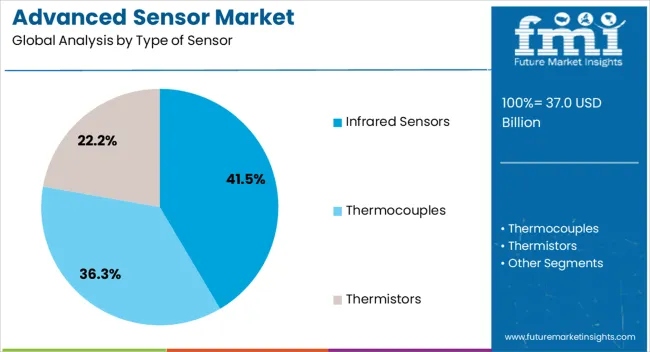
The infrared sensors segment is projected to hold 41.5% of the advanced sensor market revenue share in 2025, making it the leading sensor type. This dominance is being reinforced by their extensive use in applications requiring non-contact measurement, thermal detection, and motion sensing. Infrared sensors are widely adopted in industrial safety systems, medical diagnostics, consumer electronics, and automotive safety technologies, where accuracy and reliability are paramount.
Their ability to function effectively in varying environmental conditions while offering precise detection capabilities has supported strong market adoption. Continuous innovation in infrared technology, including improvements in sensitivity and response time, is enhancing their application range and performance in mission-critical systems. The demand for contactless solutions in healthcare and industrial sectors has also accelerated since the emphasis on safety and hygiene has grown globally.
Cost efficiency, durability, and versatility are additional factors driving their preference among end users As industries continue to prioritize automation, safety, and monitoring, infrared sensors are expected to maintain their leading role in the overall market landscape.
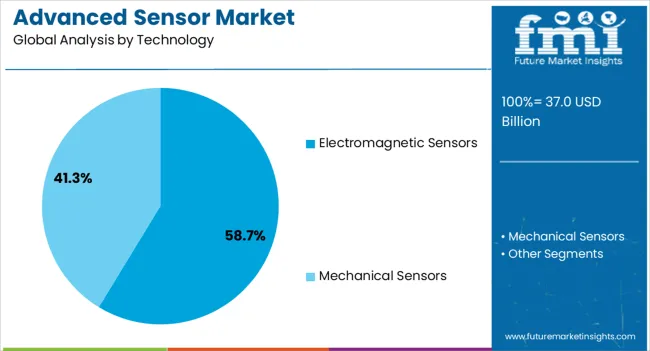
The electromagnetic sensors segment is anticipated to account for 58.7% of the advanced sensor market revenue share in 2025, positioning it as the dominant technology segment. Its growth is being driven by widespread use in measuring current, magnetic fields, displacement, and rotational speeds across industrial, automotive, and consumer applications. Electromagnetic sensors offer high reliability and precision, making them indispensable in systems where accurate monitoring of electrical and mechanical parameters is critical.
The segment is benefiting from the expansion of electric vehicles, renewable energy systems, and automation processes that require continuous monitoring of electrical currents and magnetic behavior. Advancements in sensor design are improving accuracy, reducing power consumption, and enabling integration into compact systems, further expanding their use in next-generation devices.
The ability of electromagnetic sensors to deliver consistent performance over long operational lifespans without frequent calibration is reinforcing their adoption in safety-critical environments With the growing emphasis on smart manufacturing, energy efficiency, and vehicle electrification, electromagnetic sensors are expected to remain at the forefront of technology adoption in the advanced sensor market.
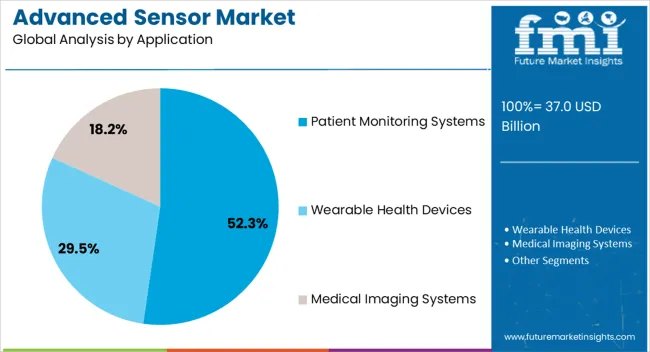
The patient monitoring systems segment is expected to capture 52.3% of the advanced sensor market revenue share in 2025, establishing itself as the leading application category. This leadership is being supported by the rising demand for real-time health data monitoring in hospitals, clinics, and home healthcare settings. The increasing prevalence of chronic diseases and the aging global population are creating greater reliance on advanced sensors to track vital signs such as heart rate, oxygen saturation, and blood pressure with high precision.
Technological advancements in wearable devices and connected health platforms are further boosting adoption, enabling continuous monitoring outside of traditional clinical environments. Regulatory support for telehealth and remote monitoring solutions is also strengthening demand, as healthcare systems seek cost-effective ways to manage patient outcomes.
The segment is also benefiting from increasing investment in digital health infrastructure, where advanced sensors form the backbone of data-driven healthcare delivery As the focus on personalized and preventive care intensifies, patient monitoring systems equipped with advanced sensors are expected to continue leading the market with sustained growth.
Sensor is a device or an element made for a purpose to detect an occurrence of any event or change in the environmental condition and if found, provide a corresponding output. Broadly, sensor is a transducer which intakes one kind of energy (mostly optical & electrical) to operate & gives different types of output.
Today sensors are being used in everyday life in every electronic product and with the advancement in technologies, the demand of instrumentation and automation has been increasing over the years and expected to grow further in the upcoming future with highest possible demand.
Advanced sensors are smart sensor which is grouping of simple sensor and meddling circuits, and are basically used for digital sensing applications across various industries such as industrial, consumer electronics, medical, automotive, security & defense and entertainment because of increasing use of process controls and sensing element in these sectors.
The consistent increasing demand of advanced sensors has continuously been increasing and is expected to grow with a double digit CAGR in the next 5-7 years, globally.
The COVID-19 fallout is unprecedented. The lockdown has restricted the international movement of non-essential goods and resources, which has put the brakes on the manufacturing of heavy electronics equipment globally. Despite the local nature and application of heavy equipment, the value and supply chains of sensor in the sector is fairly complex and distributed across the globe.
Similarly, the closing of ports has disrupted global trade in the agricultural and food sector, and with the perishable nature of these goods, there is very little that the farmers can do. This, without a doubt, will have a cascading effect on agriculture equipment manufacturers. Historically, the market for advanced sensor has grown by almost 15% globally in the past 5 years.
Due to the COVID-19 outbreak, businesses will need to scale-up or scale-down production to match demand. And to do this effectively, OEMs will require a stable yet flexible workforce that can operate and deliver from within the regulatory constraints that exist, for the market to return to steady recovery by Q1-Q2, 2025.
Growing Adoption of Smart Sensors to Overcome Security and Surveillance Issues
Internet of Things (IoT)-enabled sensors have experienced explosive growth during the last few years. Through the use of sensors, IoT deployment makes it possible for large-scale and vast physical infrastructure consisting of smart homes, autonomous vehicles, smart grid systems, and other varied devices to be tightly integrated with information and communication technologies.
A network of embedded systems can transmit information and receive instructions via distributed sensor networks. The sensors play a vital role in collecting a wide variety of information pertaining to, for instance, vehicles, environment, stress, and pressure levels in mechanical devices and surveillance of critical infrastructure.
Security becomes a major concern in IoT-enabled sensor networks, not only due to the underlying limitations of sensor nodes such as limited energy, weak processing capability, and limited memory, but also due to their physical exposure to malicious entities which result in increasing demand for the advanced sensor market.
Smart temperature sensors are used widely in measurement control systems and instrumentation. Temperature sensors provide an interpretable temperature reading in a digital format that is easy to use in many applications, such as healthcare, automotive, and building automation.
Advancements in IC technology have allowed researchers to integrate bipolar transistors in temperature sensors, along with interface electronics, to make the temperature sensor smart. As a result, the adoption of smart sensors increases the demand for the advanced sensor market.
As industrial sensors and devices create hybrid data environments, IIoT will propagate more data from more locations, in large formats and from more systems than ever before. Data management and governance challenges that have pervaded operations for decades will become a more pressing reality of the future.
Strategies to manage the volume and variety of IIoT data need to be administered now to harness the opportunity IIoT promises. Concentrators, aggregators, gateways, head-end systems are needed to aid in lifecycle management of broadly deployed sensors and devices. Hence, this factor for advanced sensor imposes a great challenge in the market growth.
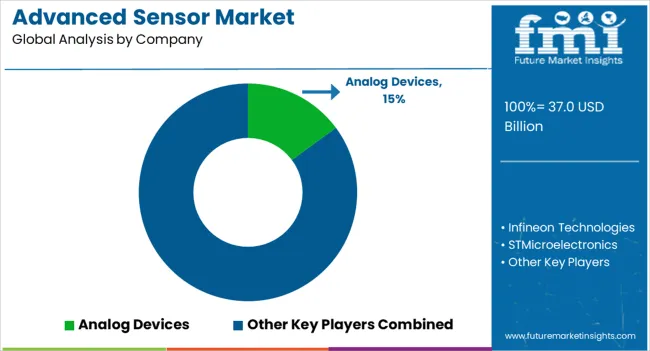
The report is a compilation of first-hand information, qualitative and quantitative assessment by industry analysts, inputs from industry experts and industry participants across the value chain of the global advanced sensor market.
The report provides an in-depth analysis of parent market trends, macroeconomic indicators and governing factors along with advanced sensor market attractiveness as per segments. The report on advanced sensor market also maps the qualitative impact of various factors on advanced sensor market segments and geographies.
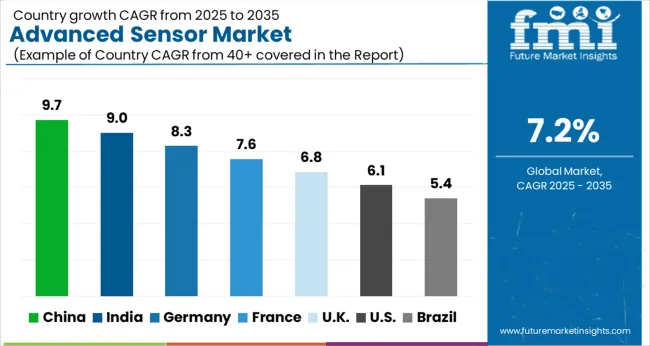
| Country | CAGR |
|---|---|
| China | 9.7% |
| India | 9.0% |
| Germany | 8.3% |
| France | 7.6% |
| UK | 6.8% |
| USA | 6.1% |
| Brazil | 5.4% |
The Advanced Sensor Market is expected to register a CAGR of 7.2% during the forecast period, exhibiting varied country level momentum. China leads with the highest CAGR of 9.7%, followed by India at 9.0%. Developed markets such as Germany, France, and the UK continue to expand steadily, while the USA is likely to grow at consistent rates. Brazil posts the lowest CAGR at 5.4%, yet still underscores a broadly positive trajectory for the global Advanced Sensor Market. In 2024, Germany held a dominant revenue in the Western Europe market and is expected to grow with a CAGR of 8.3%. The USA Advanced Sensor Market is estimated to be valued at USD 13.3 billion in 2025 and is anticipated to reach a valuation of USD 24.1 billion by 2035. Sales are projected to rise at a CAGR of 6.1% over the forecast period between 2025 and 2035. While Japan and South Korea markets are estimated to be valued at USD 2.0 billion and USD 1.3 billion respectively in 2025.
| Item | Value |
|---|---|
| Quantitative Units | USD 37.0 Billion |
| Type of Sensor | Infrared Sensors, Thermocouples, and Thermistors |
| Technology | Electromagnetic Sensors and Mechanical Sensors |
| Application | Patient Monitoring Systems, Wearable Health Devices, and Medical Imaging Systems |
| End-User Industry | Automotive Manufacturing, Food and Beverage, and Textile Manufacturing |
| Form Factor | Embedded Systems and Stationary Installations |
| Regions Covered | North America, Europe, Asia-Pacific, Latin America, Middle East & Africa |
| Country Covered | United States, Canada, Germany, France, United Kingdom, China, Japan, India, Brazil, South Africa |
| Key Companies Profiled | Analog Devices, Infineon Technologies, STMicroelectronics, TE Connectivity, Microchip Technology, NXP Semiconductors, ABB, Siemens, TDK Corporation, Robert Bosch, Honeywell International, Eaton Corporation, and General Electric |
The global advanced sensor market is estimated to be valued at USD 37.0 billion in 2025.
The market size for the advanced sensor market is projected to reach USD 74.1 billion by 2035.
The advanced sensor market is expected to grow at a 7.2% CAGR between 2025 and 2035.
The key product types in advanced sensor market are infrared sensors, thermocouples and thermistors.
In terms of technology, electromagnetic sensors segment to command 58.7% share in the advanced sensor market in 2025.






Full Research Suite comprises of:
Market outlook & trends analysis
Interviews & case studies
Strategic recommendations
Vendor profiles & capabilities analysis
5-year forecasts
8 regions and 60+ country-level data splits
Market segment data splits
12 months of continuous data updates
DELIVERED AS:
PDF EXCEL ONLINE
Advanced Process Control Market Size and Share Forecast Outlook 2025 to 2035
Advanced Active Cleaning System for ADAS Market Forecast and Outlook 2025 to 2035
Advanced Driver Assistance System (ADAS) Testing Equipment Market Size and Share Forecast Outlook 2025 to 2035
Advanced Lead Acid Battery Market Size and Share Forecast Outlook 2025 to 2035
Advanced Energy Storage System Market Size and Share Forecast Outlook 2025 to 2035
Advanced Gear Shifter System Market Size and Share Forecast Outlook 2025 to 2035
Advanced Therapeutics Pharmaceutical Outsourcing Market Size and Share Forecast Outlook 2025 to 2035
Advanced Airport Technologies Market Size and Share Forecast Outlook 2025 to 2035
Advanced Air Mobility Market Size and Share Forecast Outlook 2025 to 2035
Advanced Combat Helmet Market Size and Share Forecast Outlook 2025 to 2035
Advanced Optics Material Market Size and Share Forecast Outlook 2025 to 2035
Advanced Functional Materials Market Size and Share Forecast Outlook 2025 to 2035
Advanced Drill Data Management Solutions Market Size and Share Forecast Outlook 2025 to 2035
Advanced Water Management And Filtration Equipment Market Size and Share Forecast Outlook 2025 to 2035
Advanced Coating Market Size and Share Forecast Outlook 2025 to 2035
Advanced Aerospace Coatings Industry Analysis in Europe - Size, Share, and Forecast 2025 to 2035
Advanced Tires Market Size and Share Forecast Outlook 2025 to 2035
Advanced Therapy Medicinal Products Market Size and Share Forecast Outlook 2025 to 2035
Advanced Glass Market Size and Share Forecast Outlook 2025 to 2035
Advanced Server Energy Monitoring Tools Market Size and Share Forecast Outlook 2025 to 2035

Thank you!
You will receive an email from our Business Development Manager. Please be sure to check your SPAM/JUNK folder too.
Chat With
MaRIA